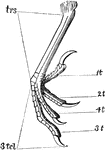Clipart tagged: ‘bird feet’
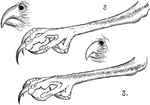
The Beaks and Claws of a Burrowing Owl
"Speotyto. Burrowing Owls. tarsi long, about twice as long as the middle toe without its claw, very…

Typical Passerine Bird Feet
"Fig. Typical passerine feet. The right hand fig. is plectrophanes lapponicus." Elliot Coues, 1884

The Foot of a Bridled Foot
"Sterna anaisthetikos. Bridled Tern. The foot of a Bridled Tern; Tarsus .85; middle toe the same, with…

Foot of Honey-Buzzard
"In birds of prey the claws are powerful and hooked; in others the foot is flat, claws straight, and…

Phalanges of Caprimulgine
"Fig. 41 shows phalanges of caprimulgines foot, where the ratio is 2, 3, 4, 4." Elliot Coues, 1884

Foot of Cassowary
"In birds of prey the claws are powerful and hooked; in others the foot is flat, claws straight, and…

Scutellate Laminiplanter Tarsus of a Cat-bird
"Figure shows Scutellate laminiplanter tarsus of a cat-bird. A tarsus so disposed as to its podotheca…
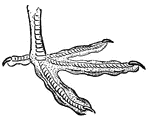
Foot of Coot
"The great toe is generally the strongest, but this is not an absolute law; a projection which is found…
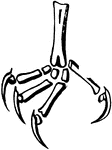
Phalanges of Cypseline Foot
"Fig. 40 Phalanges of Cypseline foot, where the ratio is 2, 3, 3, 3 of Caprimulginae." Elliot Coues,…

White-fronted Dove Details
"Details of Engyptila albifrons (White-fronted Dove); head and foot natural size; wing and tail reduced.
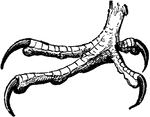
Foot of White-Headed Eagle
"In birds of prey the claws are powerful and hooked; in others the foot is flat, claws straight, and…

Grackle Foot
"Quiscalus. Grackle. The feet are large and strong, and the birds spend much of their time on the ground,…

The Raptorial Foot of a Hawk
"Fig. 46. - Raptorial foot of a hawk, Accipiter cooperi. The raptorial is another modification of the…
The Foot of a Prairie Hen
"Cupidonia. Tarsi scant-feathered to the toes in front and on sides, bare on a strip behind; toes extensively…

The foot of a Kingfisher
"Fig. 44- Syndactyle foot of a kingfisher. Thus a kingfisher shows what is called a syndactyle or syngnesious…

The Raptorial Foot of an Owl
"Fig. 47. - Raptorial foot of an owl, The raptorial is another modification of the insessorial foot.…
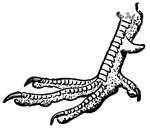
Foot of Pheasant
"The great toe is generally the strongest, but this is not an absolute law; a projection which is found…

Quail Foot and Bill
"Ortyx. Quail. Outstretched feet reaching beyond end of tail. Bill black or blackish-brown. " Elliot…
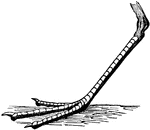
Tridactyle Foot of a Sanderling
"Fig. 39 shows a Tridactyle foot of a sanderling, Calidris arenaria." Elliot Coues, 1884

Sooty Tern Foot
"Sterna fuliginosa. Sooty Tern. feet stout; toes short; with much incised webs; tibia bare .70; tarsus…
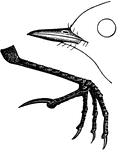
American Titlark Claw
"Anthus Ludovicianus. Louisiana Pipit. American Titlark. Brown Lark. Wagtail. Bill blackish, pale at…

Zygodactyle Foot of a Woodpecker
"Fig. 45.- Zygodactyle foot of a woodpecker, Hylotomus pileatus. The zygodactyle or yoke-toed modification…
